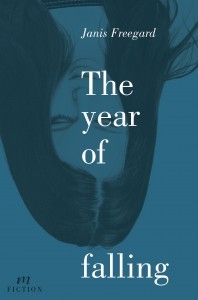What I’m Reading: “The year of falling” by Janis Freegard
 A few weeks back I trumpeted the arrival of Janis Freegard’s The year of falling (Mākaro Press, 2015) on my TBR table.
A few weeks back I trumpeted the arrival of Janis Freegard’s The year of falling (Mākaro Press, 2015) on my TBR table.
Now it’s time for a confession: because Janis is a friend and fellow (former) Tuesday Poet, I allowed The year of falling to leapfrog several other books to become my “next best read” — and so, indeed, it proved because I really enjoyed The year of falling.
Truth to tell, I suspected I might, simply because I always ‘heart’ Janis’s poetry and loved her short story The Magician, which featured in Tales for Canterbury (Random Static, 2011) a few years back. However, I’m also aware that sustaining creativity, storytelling, and art over a novel-length work is a very different proposition to a poem or short story. Nonetheless, I was eager to read The year of falling and was definitely not disappointed.
First, a little about the story. The year of falling is “contemporary realism” fiction, mainly set in Wellington and Golden Bay, but also the UK and Iceland (yep, this story has stamps in its passport. 🙂 ) It chiefly follows two sisters, Selina and Smith, but there’s also a third point of view character, Quilla, who is Selina’s landlady and turns out to be a person with a past.
I believe it is fair to say that it is chiefly Selina’s arc that drives the story in the first two thirds of the book, although the final third is concentrated around Smith. The focus of the story is Selina’s “fall” and what comes of that, but it’s chiefly a story about relationships, both positive and negative: between the sisters, but also between friends, partners, and also the more tangential connections between neighbours. However, there is also an element of whodunnit woven into the story, which I enjoyed.
Very quickly, I found myself engrossed in the characters and their stories, to the extent I did not want to put the book down until I found out how it was all going to resolve. The characters are definitely one of the standout aspects of an already good story and I thought the troubled Selina (a “fuckup” to put it mildly, but in a sympathetic way) was particularly well-drawn, with Smith and Quilla both strong in their supporting roles.
I also really liked the “quirkyness” of the story, which is captured not only in some of Selina’s activities (or escapades) including the conclusion of her part in the story, but also Quilla’s past and the activities of the neighbourhood children, all of which spring vividly to life in vignettes interspersed through the (main) story. Another element that I enjoyed was the use of recognisable New Zealand landscapes, both urban Wellington and rural Golden Bay, sufficient to inspire several “aha!” moments.
“Constancy” was undoubtedly the touchstone to Smith’s character, but may also have worked against a strong sense of her development through the story. I was also slightly disconcerted by the extent of the switch in focus from Selina to Smith in the latter third of the book.
Conclusion:
Overall, I thoroughly enjoyed The year of falling and recommend it unreservedly. Although in many ways a unique book, with Christmas and the summer break looming I think it would make mighty fine holiday reading for anyone who enjoys reads such as Frankie McMillan’s short fiction (e.g. The Bag Lady’s Picnic; My Mother and the Hungarians), Kate Atkinson’s Life After Life, or Joanne Harris’ Blackberry Wine.
—
 Additional Information:
Additional Information:
I read the NZ paperback edition, 294 pp, published by Mākaro Press (2015). As noted above, Janis is a friend and I read a copy she provided in an authorial “exchange of books.”
To read Janis’s 2015 interview of Selina, Smith, and Quilla, click here.







